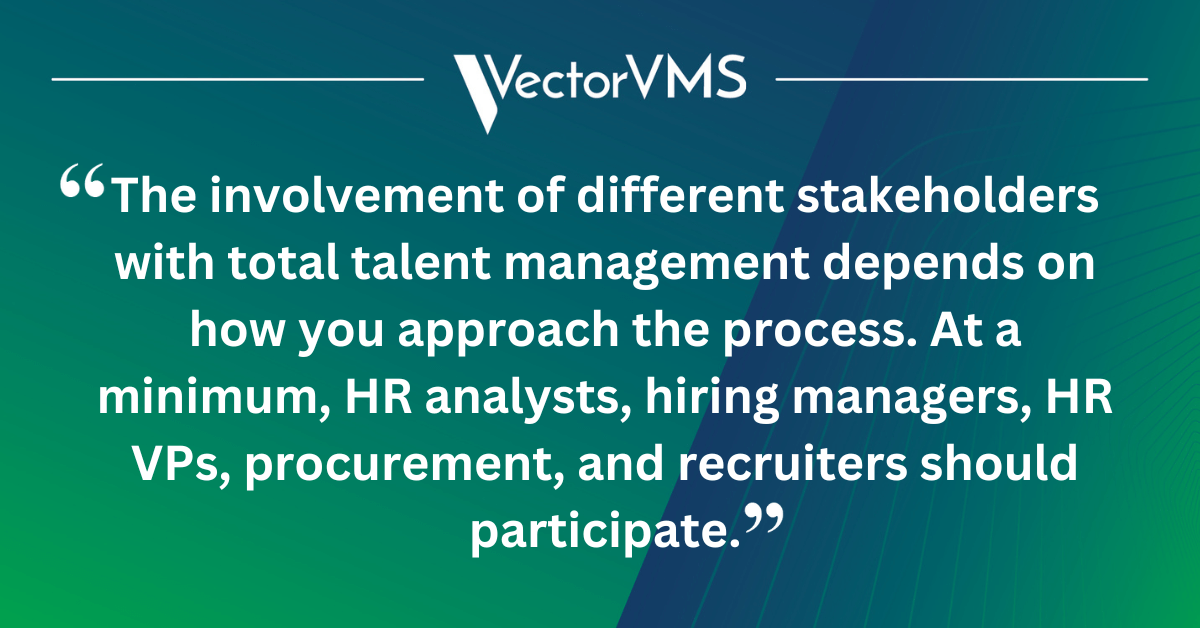The way we manage talent is changing. In a fast-paced world, traditional HR practices are no longer enough to keep up with the demands of the modern workforce. That’s where total talent management and a vendor management system (VMS) come in.
A total talent management approach requires you to examine your enterprise-wide process for obtaining talent, including its technology. It involves deciding how to best fill roles by considering all available talent, whether that’s full-time staff or contingent workers, and whether those contingent workers are freelancers, independent contractors, or individuals engaged via a statement of work (SOW). By looking at all available talent, you can choose the best fit for your organization.
This “total” approach to talent management looks at your entire workforce, whether traditional or non-traditional. This is because each group provides valuable services and should be seen as an asset within your company. By grouping all talent types together and looking at them as a total group of talent, you can view your current capabilities and determine the most appropriate resource to fill an open position. This process ultimately enhances scalability and creates a more agile workforce.
Total talent management is an effective solution for all organizations that work with extended labor, however, there’s a vital piece to getting it right: cross-team collaboration. Good team communication and engagement is the stepping stone toward a successful total talent management strategy. In this article, we’ll explain three steps to help you guarantee optimal team collaboration.
1. Define the Key Players
Planning a total talent management strategy begins with understanding the key players you’ll need to have involved. Bring every team needed for the process to the table early, discuss how you’ll look at total talent, interact with each other, and integrate in order to develop an on-demand workforce.
Once you’ve defined who’s involved and how you’ll operate, introduce yourself to your total talent team. Then, make sure to communicate on a regular basis. Whether it’s through cadence calls or email groups, it’s important to get everyone together and communicate how each person is important to achieving the total talent acquisition team’s strategy.
Early on in your process, you’ll want to meet and talk about capabilities. It’s important to understand what each department and person does, as well as the type of technologies being utilized. Assess where each person belongs and how they can contribute to the strategic plan.
YOU MIGHT LIKE | ‘Build Your Total Talent Management Dream Team: Who to Include and Why’

Who Should Be Involved?
The involvement of different stakeholders with total talent management depends on how you approach the process. At a minimum, HR analysts, hiring managers, HR VPs, procurement, and recruiters should participate.
A project manager and someone close to the technology you’ll be using are both easy-to-miss but valuable assets. An expert in the technology can assess whether a solution can integrate with existing systems, how to do it, and how long integration will take. Equally, you’ll need a project manager who can handle all the necessary communication. Many of our clients use three or four talent acquisition tools, requiring coordination among a lot of people with different responsibilities. Don’t hesitate to involve your project management department to help manage the process.
LEARN MORE | ‘The Power of AI and How It Can Transform Your Talent Acquisition Strategy’
2. Break Down the Silos
When gathering all the teams together, organizations often find that each team operates in its own silo. For example, It’s common that contingent workers are brought in through a VMS because, for scalability, organizations turn to temporary talent to fill key roles quickly. But you often find that those workers are never really integrated into the workforce.
It’s crucial to know who all the players are in order to break down the silos. Understanding the role of each team and its place at the table. Every team has its own perspective and needs, it’s important to hear every side of the story and come up with solutions that work for everyone. For example, procurement’s job is always going to be to save money, push contracts, and make sure they’re getting the best deal and the best technology. But HR is on the front lines every day. They’re out there witnessing the talent shortage and how hard it is to fill key roles.

3. Create an Action Plan
The culmination of the team’s initial fact-finding should be to create an action plan, as this will allow you to set expectations and define responsibilities. This action plan should:
- Create milestones, check-ins, and timelines.
- Define the intended outcomes, how to measure them, and how to present them to leadership.
- Define what success looks like.
One helpful approach may be to focus on one area of “low-hanging fruit” in the early stages—something with the potential to make a large initial impact and create success right away.
MORE ON TOTAL TALENT | ‘The 5 Key Phases of Designing Your Dream Total Talent Management Program’
The Tools You Need for Total Talent Management
Total talent management is revolutionizing the way we manage talent. By taking a holistic approach to talent management and incorporating non-employees into your strategies, you can access a wider pool of talent, optimize your workforce costs, and remain competitive.
However, your total talent approach needs the right technology if it’s going to function properly. A VMS is an essential component of a total talent management strategy. It can work as your single source of truth and it gives you an easy and automated way to broadcast your contingent positions to your staffing suppliers and your contingent workforce. A VMS allows you to focus on building out the strategic components of your workforce—including total talent management.
Learn more about total talent management and how to incorporate it into your organization. Download our ebook ‘Total Talent Management: 3 Considerations for Revolutionizing the Way We Manage Talent’. Alternatively, get in touch with us and start implementing a successful program!
 Meet the Expert
Meet the Expert
Taylor Ramchandani – VP of Strategy
Taylor Ramchandani is responsible for the management and strategic planning of the VectorVMS vendor management system. Taylor is committed to client satisfaction and to ensuring VectorVMS technology meets the current and future needs of clients and managed service providers (MSPs). She uses market research and in-depth industry experience to create products and services that make extended workforce management efficient and intuitive. Taylor oversees product development, marketing, and business partnerships for VectorVMS and is responsible for driving innovation for contingent workforce management. Connect with her on LinkedIn.



